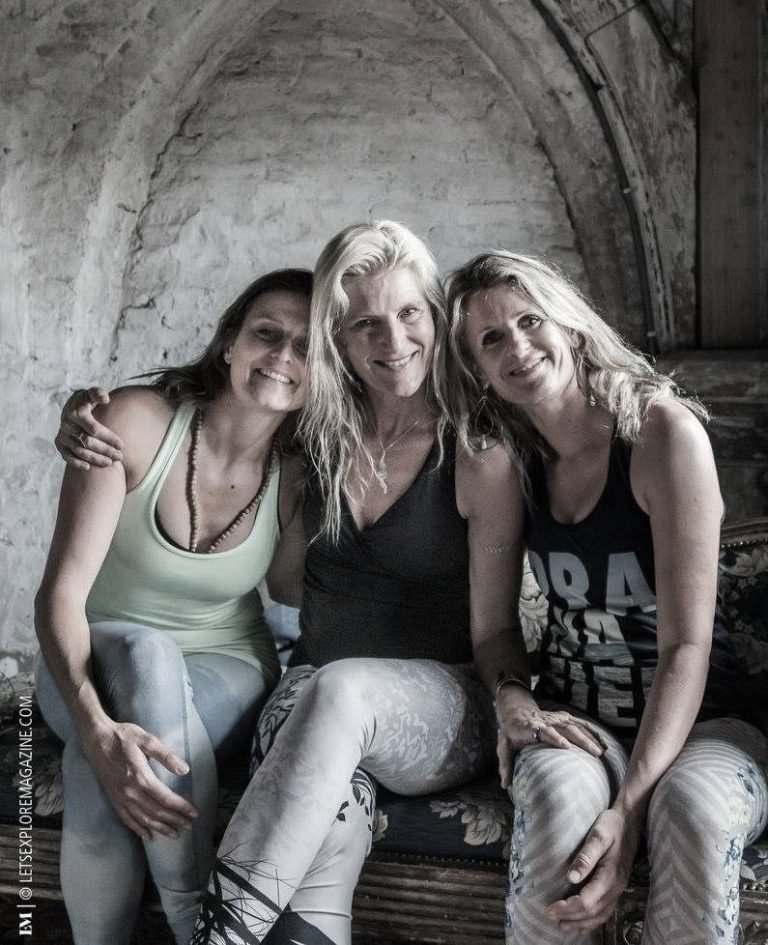Vinyasa Flow is one of the deepest of yoga practices
Episode 5: Podcast with Hilary Brown and Nele Van Poucke.
Not so simple…or is it?
In this fifth episode of Conversations Beyond the Mat, Hilary Brown talks with Nele van Poucke who is deeply immersed in Prana Vinyasa yoga. With over 17 years of yoga experience, certified Prana Vinyasa Teacher, owning her yoga studio in Mechelen, traveling the world sometimes assisting Shiva Rea her source teacher, Nele inspires yogis to deepen their practice, and let them evolve into experienced, expert teachers. Her classes are powerful, yet calming, and with the timbre of her voice she guides you out of your head and into your body, in a soft and meditative way.
Podcast maker Hilary Brown is the founder & creative director of Yoga Moves Training Programs in The Netherlands.
Excerpt from full transcript:
Hilary:
…what is the principle of Vinyasa? What is Vinyasa for you? Because we know it’s so much deeper, can just share our understanding of that, from the depth of your understanding, but also for someone new walking in.
Nele:
I’m going to quote Shiva on this one, “feel the pulse of life”. When I heard that I thought, “yeah, you have me” because that what I feel Vinyasa is. Some translate Vinyasa as ‘to place in a special way’, while others translate as ‘connecting your movements to your breath’. Okay, you do that in Ashtanga as well, but with Vinyasa it’s really about feeling the pulse of life, feeling what’s going on in that present moment…and using the five movements of prana, which is next level. It’s about getting in touch with elements of nature. So for example, if you feel up in your head, you’re going to focus more on Earth. If you feel stuck and you’re not creative, you’re going to focus on water…
…
Hilary:
How do we (as teachers) channel and create space for people to be in (the flow)? What is happening, could be internally like you said, your own internal life emotions, or externally… So, feel the pulse of life, how do you translate that for someone that’s new to this? Or, the other interesting question is for people that are new to the path of teaching, what would you say would be the most important thing on this topic?
Nele:
The most important thing I feel is as a teacher, you need to tune in. That’s the first thing.
And how I like to translate the pulse of life is that it’s really the rhythm of the breath, because that’s always where you start, with the rhythm of the breath. And always allowing them to feel.
And it’s even without doing any asanas.
It’s difficult to explain that in one class. So, I usually tell them as well, “It’s okay to feel uncertain.. and it’s okay to feel weird, because it’s a process”. So when I teach a beginner’s class, I like to teach it more in a series. I can take them, from the beginning, and then take them in a four month journey, or in a one month journey, because it’s really difficult to explain in one go. So, I always like to explain it in little snippets. Like first, we focus on the breath. And then we focus for example, to move the arms in the beginning. So, they feel like they’re connecting the movement with the breath. Maybe one little snippet of knowledge and for the rest is just try to find…try to feel. And I just do, and that’s the thing I keep repeating. What are you feeling? Are you really feeling? Why are you doing this?
….
Hilary:
Can you give our listeners a very brief verbal experience of the five pranas, is that to do without visual?
Nele:
I think I have quite a fluctuating practice through the month. So there are things that I do not want to do at certain times in the month. I haven’t finished my period. So I’m in peri-menopause. And what I’ve noticed is, I’ve become very much more sensitive to what I want to do on a particular day, depending where I am in, in the cycle, which I found really interesting.
Hilary:
I always say there is Prana in everything, that means everything and even you know, that stone on the ground. Yeah, maybe not a lot of Prana but there’s some. But basically, we’re talking about the way energy moves and the way it’s in nature, but also in our bodies and energy. Sometimes it’s referred to as breath, but it’s much more than just breath. I mean, it’s how energy moves.
Nele:
A lot of people get stuck on the word Prana, and they think it’s a lot of pranayama breathwork. But it’s linked to the five movements of Prana, and using that in your class, and using that knowledge to teach energetic alignment. So instead of having to say all the different body parts and anatomy cues, just by directing where they have to place the energy you can help them. And it’s also easy to see as a teacher where the energy is lacking. Instead of trying to fix it and be like “Oh, put this there, put this there”, you can try to explain with your words and with the movement, what they have to engage and what they have to let go. So, they feel it. It makes my life easy. A lot of people don’t know where, okay, they know the quadriceps and they know the hamstrings, but when I use anatomical language, you get back into your head. And we just want people to get back into their bodies. So when you use that knowledge of the five movements of prana, it’s an experience. It’s not just intellectual, but you feel it in your body. You maybe don’t understand it, but you feel it.
Want to explore more?
Deepen your practice with Embodying the Elements - Prana Mandala Vinyasa, a transformative workshop guided by Shiva Rea from June 5 to June 8, 2025. Over these four days, you'll journey through the five elements—earth, water, fire, air, and space—while exploring the circular movements and energetic sequencing of Mandala Vinyasa. This is your chance to experience the deeper layers of flow and embodiment with one of the world’s leading teachers.

